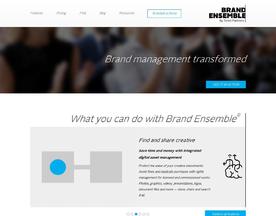What are brand assets? Brand assets are unique elements like logos, colors, and fonts that distinguish a brand and enhance its recognition and value.
Brand assets are a crucial component of any successful business. They are the visual, auditory, and emotional elements that make up a brand’s identity and help to differentiate it from its competitors. Brand assets can include everything from a company’s logo and color scheme to its advertising campaigns and customer service experience.

Brand Identity Fundamentals are the backbone of any successful brand. It is important to have a clear understanding of what your brand stands for, what it offers, and who its target audience is. This information should be reflected in every aspect of your brand’s identity, from its logo and visual elements to its messaging and marketing efforts. A strong brand identity can help to build customer loyalty and increase brand recognition.
Key Takeaways
- Brand assets are crucial for building a successful brand identity.
- Brand Identity Fundamentals are the backbone of any successful brand.
- A strong brand identity can help to build customer loyalty and increase brand recognition.
Brand Identity Fundamentals
Defining Brand Assets
Brand assets refer to the unique elements that contribute to a brand’s identity and help differentiate it from its competitors. These assets can be tangible, such as a logo or packaging design, or intangible, such as the brand’s values and personality.
A brand’s identity is more than just its visual appearance; it encompasses its values, mission, and personality. Consistency is key in maintaining a strong brand identity, as it helps build trust with customers and creates a lasting relationship.
Visual identity is a crucial component of a brand’s identity. It includes elements such as color schemes, typography, and imagery, which work together to create a cohesive and recognizable visual representation of the brand.
Importance of Brand Identity
A strong brand identity is essential for businesses of all sizes. It helps create a sense of trust and reliability with customers, which can lead to increased loyalty and sales. A clear and consistent brand identity also helps businesses stand out in a crowded marketplace.
By defining their brand assets and consistently communicating them across all touchpoints, businesses can establish a strong brand identity that resonates with their target audience.
According to Forbes, “a strong brand identity can make your business more memorable, build trust with your target audience, and ultimately drive sales and revenue.”
In summary, understanding and defining a brand’s identity and assets are crucial for building a strong and recognizable brand. By maintaining consistency and effectively communicating these assets, businesses can establish trust with their customers and stand out in a competitive marketplace.
Logo and Visual Elements
A brand’s visual identity is critical to its success, and the logo is the most recognizable aspect of that identity. A logo should be simple, memorable, and versatile enough to work across a range of applications, from business cards to billboards.
Logo Design
When designing a logo, it’s essential to consider the brand’s personality and values. Apple’s logo, for example, is clean, simple, and elegant, reflecting the company’s focus on innovation and simplicity. A well-designed logo should be easily recognizable, even at a small size, and work well in both color and black and white.
Color Palette
A brand’s color palette is another crucial aspect of its visual identity. Colors can evoke emotions and convey meaning, so it’s essential to choose colors that align with the brand’s personality and values. A brand’s color palette should be consistent across all applications, from the website to marketing materials.
Typography
Typography is another critical visual element of a brand’s identity. Brand fonts should be easy to read and consistent across all applications. It’s also essential to choose fonts that reflect the brand’s personality and values. For example, a law firm might choose a serif font to convey a sense of tradition and professionalism, while a tech startup might opt for a sans-serif font to convey a sense of modernity and innovation.
Imagery and Photography
Imagery and photography are also essential visual elements of a brand’s identity. The images a brand uses should reflect its personality and values and be consistent across all applications. It’s also essential to choose images that resonate with the brand’s target audience. For example, a fitness brand might use images of active people to appeal to health-conscious consumers.
To learn more about creating a strong visual identity for your brand, check out this guide from HubSpot: How to Create a Brand Style Guide.
Brand Messaging
Brand messaging is a crucial aspect of any successful branding strategy. It involves creating a consistent message that resonates with the target audience and communicates the brand’s values, personality, and unique selling proposition.
Slogan and Tagline Creation
A brand’s slogan or tagline is a short and memorable phrase that captures the essence of the brand and its promise to the customers. It should be catchy, simple, and easy to remember. A well-crafted slogan or tagline can help differentiate the brand from its competitors and create a lasting impression in the minds of the customers.
To create a compelling slogan or tagline, it is important to understand the brand’s target audience, unique selling proposition, and brand personality. The slogan or tagline should reflect the brand’s values, mission, and vision. It should also be consistent with the brand’s voice and tone.
One example of a successful tagline is Nike’s “Just Do It.” This tagline captures the brand’s spirit of determination and motivation, and has become synonymous with Nike’s brand identity.
Brand Voice and Tone
A brand’s voice and tone are the personality and style of the brand’s communication. It is the way the brand speaks to its audience and the emotions it evokes. A consistent voice and tone can help build trust and familiarity with the audience, and create a strong brand identity.
To develop a brand’s voice and tone, it is important to understand the brand’s values, target audience, and unique selling proposition. The brand’s voice should be consistent across all communication channels, including social media, advertising, and customer service. The tone should be appropriate for the audience and the context.
One example of a brand with a strong voice and tone is Apple. Apple’s communication is simple, elegant, and focused on the user experience. The brand’s voice is confident and knowledgeable, while the tone is friendly and approachable.
In conclusion, creating a strong brand messaging strategy is crucial for any successful branding effort. By developing a compelling slogan or tagline and a consistent voice and tone, brands can differentiate themselves from their competitors and build a strong emotional connection with their audience.
For more information on creating a successful brand messaging strategy, check out this article from Forbes Agency Council.
Marketing and Promotion

When it comes to promoting a brand, having a strong marketing strategy is key. This involves utilizing various marketing channels to reach out to potential customers and increase brand awareness. In this section, we will explore some of the ways in which a brand can market and promote its assets.
Marketing Campaigns
Marketing campaigns are a great way to promote a brand and its assets. These campaigns can take many forms, including print and digital ads, social media campaigns, and email marketing. A successful marketing campaign can help a brand reach a larger audience and increase brand awareness.
One example of a successful marketing campaign is the “Share a Coke” campaign by Coca-Cola. This campaign involved printing popular names on Coke bottles and cans, encouraging customers to share a Coke with friends and family. This campaign not only increased sales but also generated a lot of buzz on social media.
Digital and Social Media Presence
In today’s digital age, having a strong online presence is essential for any brand. This includes having a well-designed website and active social media profiles. A brand’s website should be easy to navigate and provide customers with all the information they need about the brand and its assets.
Social media is also an important tool for promoting a brand. Platforms such as Facebook, Twitter, and Instagram allow brands to engage with customers and build a loyal following. By posting regular updates and interacting with customers, a brand can increase brand awareness and loyalty.
Audio and Video Assets
Audio and video assets are also important for promoting a brand. This includes jingles, music, and videos. Jingles and music can help create a memorable brand identity, while videos can be used to showcase a brand’s products or services.
One example of a successful use of audio assets is the Intel bong sound. This sound is instantly recognizable and has become synonymous with the Intel brand. Similarly, the use of video assets has been successful for brands such as Nike, whose “Just Do It” campaign featuring inspirational videos has helped increase brand loyalty and sales.
In conclusion, marketing and promotion are essential for any brand looking to increase brand awareness, loyalty, and sales. By utilizing various marketing channels and creating strong audio and video assets, a brand can successfully promote its assets and build a strong customer base. For more information on marketing and promotion strategies, check out this article by Forbes.
Consistency Across Platforms

Maintaining consistency across all platforms is crucial for any brand. It ensures that the brand’s message and image remain intact, regardless of the platform used to convey it. Consistency is key to building a strong brand identity and increasing brand recognition.
Brand Guidelines
Brand guidelines are an essential tool for ensuring consistency across platforms. A branding guide outlines the rules for using the brand’s design elements, such as the logo, color scheme, and typography. It also provides guidance on tone of voice and messaging. By adhering to the guidelines, all touchpoints with the brand will be consistent, from the website to social media to physical packaging.
Packaging and Merchandising
Packaging and merchandising are two areas where consistency is particularly important. Packaging is often the first point of contact a consumer has with a brand, and it’s essential that it conveys the brand’s message and image accurately. Merchandising, such as in-store displays, must also be consistent with the brand’s overall strategy.
To maintain consistency, a brand’s packaging and merchandising should feature the same design elements and messaging as other touchpoints. This includes using the same color scheme, typography, and imagery. By doing so, the brand will be easily recognizable across all platforms.
In conclusion, consistency is crucial for building a strong brand identity and increasing brand recognition. By following brand guidelines and maintaining consistency across all touchpoints, a brand can ensure that its message and image remain intact, regardless of the platform used to convey it.
Here is an external resource that provides more information on brand guidelines and their importance in maintaining consistency.
Customer Perception and Loyalty

Building a strong brand is essential for any business that wants to succeed. One of the most important aspects of branding is customer perception. The way customers perceive a brand can have a significant impact on their buying decisions and their loyalty to the brand.
Building Trust and Loyalty
Trust is a critical factor in building customer loyalty. Customers are more likely to remain loyal to a brand if they trust it. One way to build trust is through consistent branding. When a brand is consistent in its messaging, visual identity, and overall approach, it helps customers feel more confident in their buying decisions. Consistency can also help to reinforce brand recognition, which is another essential factor in building customer loyalty.
Another way to build trust and loyalty is through association. Brands that are associated with positive feelings or experiences are more likely to be trusted and have loyal customers. For example, a brand that is associated with high-quality products or exceptional customer service is more likely to have loyal customers.
Customer Service and Support
Customer service and support are also critical factors in building customer loyalty. When customers have a positive experience with a brand’s customer service, they are more likely to remain loyal to the brand. On the other hand, a negative experience can quickly turn customers away.
One way to ensure positive customer service and support is through habit. When a brand consistently provides excellent customer service and support, it becomes a habit for customers to turn to that brand when they need assistance. This habit can lead to increased customer loyalty.
Overall, building customer perception and loyalty is essential for any business that wants to succeed. By focusing on consistent branding, positive association, and exceptional customer service and support, brands can build strong relationships with their customers that can last for years to come.
Here is an external resource with more information on how to build customer loyalty.
Competitive Differentiation

In a crowded marketplace, it is important for a brand to stand out from its competitors. This is where competitive differentiation comes into play. By emphasizing what makes a brand unique, it can create a distinct identity that sets it apart from the competition.
Research and Analysis
To create a unique brand identity, it is important to conduct thorough research and analysis. This includes researching competitors to identify gaps in the market and opportunities for differentiation. In addition, brand managers should analyze their own brand assets, such as their brand name, catchy jingle or slogan, and mascots, to determine what is resonating with consumers and what is not. By analyzing this data, brand managers can make informed decisions about how to differentiate their brand.
One example of a brand that has successfully differentiated itself is Coca-Cola. The company has built a strong emotional connection with consumers through its iconic red and white logo, catchy jingle, and memorable slogan, “Taste the Feeling.” By consistently emphasizing these brand assets, Coca-Cola has become one of the most recognizable brands in the world.
Unique Selling Proposition
Another important aspect of competitive differentiation is the unique selling proposition (USP). This is the one thing that sets a brand apart from its competitors and makes it the obvious choice for consumers. By identifying and emphasizing its USP, a brand can create a strong emotional connection with consumers and build brand loyalty.
Nike is a great example of a brand with a strong USP. The company’s “Just Do It” slogan and iconic swoosh logo emphasize the brand’s focus on inspiring and empowering athletes to achieve their goals. By consistently emphasizing this message, Nike has become one of the most successful athletic brands in the world.
In conclusion, competitive differentiation is essential for building a strong brand identity and standing out in a crowded marketplace. By conducting thorough research and analysis, emphasizing key brand assets, and identifying a strong USP, brands can create a distinct identity that resonates with consumers and builds brand loyalty. For more information on brand management and competitive differentiation, check out this link from Forbes.
Legal and Ethical Considerations

Intellectual Property
When it comes to brand assets, intellectual property (IP) is a crucial consideration. IP includes trademarks, copyrights, patents, and trade secrets. Companies need to ensure that they have legal ownership of their brand assets and that they are not infringing on the IP of others. In addition, companies need to protect their brand assets from unauthorized use. This can be achieved through legal measures such as trademark registration and monitoring, as well as through technological measures such as watermarking and digital rights management.
One important aspect of IP is the use of third-party content. Companies should be aware of the licensing requirements for any third-party content they use, such as images, music, or video. Failure to obtain proper licenses can result in legal action and damage to the company’s reputation.
Misrepresentation and Compliance
Misrepresentation of brand assets can have serious legal and ethical consequences. Companies need to ensure that their brand assets are not being used in a way that misleads consumers or damages the company’s reputation. This includes ensuring that brand assets are not being used in a way that implies endorsement or affiliation with another company or product.
Compliance with regulations and industry standards is also important when it comes to brand assets. For example, companies need to ensure that their advertising and marketing materials comply with the Federal Trade Commission’s guidelines on truth in advertising. Failure to comply with regulations and standards can result in legal action and damage to the company’s reputation.
To learn more about legal and ethical considerations for brand assets, check out this resource from the World Intellectual Property Organization.
Brand Asset Management

Brand asset management refers to the process of organizing, storing, and distributing a company’s brand assets. These assets can include logos, images, videos, and other digital assets that are used to represent the company’s brand identity. Effective brand asset management can help ensure that all stakeholders have access to the most up-to-date and accurate brand assets, which can help maintain brand consistency and improve overall brand recognition.
Digital Asset Management
Digital asset management (DAM) is a key component of brand asset management. DAM involves the use of software tools to organize and manage digital assets, making it easier to search for and access the assets as needed. A good DAM system can help ensure that all users have access to the most up-to-date and accurate brand assets, while also providing tools for managing usage rights and tracking asset performance.
One popular DAM tool is Adobe Experience Manager, which offers a range of features for managing digital assets, including metadata tagging, version control, and access control. Another popular option is Bynder, which offers a cloud-based platform for managing digital assets across multiple channels and devices.
Employee Advocacy
Employee advocacy is another important aspect of brand asset management. By empowering employees to become brand advocates, companies can leverage their employees’ social networks to expand their reach and improve brand awareness. This can be done through employee advocacy programs, which provide employees with tools and resources for sharing branded content on social media.
One example of an employee advocacy platform is Hootsuite Amplify, which allows companies to curate and distribute content to employees, who can then share it on their social networks. Another option is Dynamic Signal, which offers a range of features for managing employee advocacy programs, including content curation, gamification, and analytics.
Overall, effective brand asset management is essential for maintaining brand consistency and improving brand recognition. By leveraging digital asset management tools and empowering employees to become brand advocates, companies can ensure that their brand assets are being used effectively and efficiently.
Psychology and Influence

Brand assets are not just visual elements. They have the power to influence people’s emotions and behavior. Understanding the psychology behind brand assets is crucial for creating effective branding strategies. In this section, we will explore how brand assets can influence people’s emotions and behavior.
Color Psychology
Color psychology is the study of how colors affect human behavior and emotions. Colors can evoke different emotions and associations, and they can influence people’s perception of a brand. For example, the color red is associated with passion, energy, and excitement. It can be used to create a sense of urgency or to grab people’s attention. On the other hand, blue is associated with trust, calmness, and reliability. It can be used to create a sense of security and stability.
According to a study by the University of Loyola, Maryland, color can increase brand recognition by up to 80%. This shows how important it is to choose the right colors for your brand. It’s also important to consider cultural differences when choosing colors, as different cultures have different associations with colors.
Emotional Connections
Emotional connections are the feelings and associations that people have with a brand. They are created through the use of brand assets such as logos, slogans, and brand messaging. Emotional connections can be positive or negative, and they can influence people’s loyalty and behavior towards a brand.
According to a study by the Harvard Business Review, customers who have an emotional connection with a brand are 52% more valuable than those who do not. This highlights the importance of creating emotional connections with your customers.
Brand assets can create emotional connections by appealing to people’s values, beliefs, and aspirations. For example, a brand that promotes sustainability and environmentalism can create an emotional connection with customers who share those values.
In conclusion, understanding the psychology behind brand assets is crucial for creating effective branding strategies. By using color psychology and creating emotional connections, brands can influence people’s emotions and behavior towards their brand. To learn more about color psychology and emotional connections, check out this resource by Verywell Mind.
Innovation and Evolution

As brands continue to evolve, it is crucial for them to adapt to market trends and consumer preferences. This means that brand assets must be constantly updated and refined to reflect changing times.
Adapting to Market Trends
One way to stay ahead of the curve is to keep a close eye on market trends. This includes monitoring consumer behavior and preferences, as well as keeping up with emerging technologies and platforms. By doing so, brands can ensure that their assets remain relevant and effective.
For example, a brand might update its logo to reflect a more modern aesthetic or redesign its website to be more mobile-friendly. By making these changes, the brand can improve its overall user experience and appeal to a wider audience.
Influencer and Partnership Marketing
Another way to stay relevant is through influencer and partnership marketing. By partnering with influencers or other brands, a company can expand its reach and tap into new audiences.
For instance, a brand might collaborate with a popular influencer to create a series of sponsored posts or videos. This can help to increase brand awareness and drive engagement among the influencer’s followers.
Overall, innovation and evolution are key to building a successful brand. By staying up-to-date with market trends and exploring new strategies, brands can continue to grow and thrive in an ever-changing landscape.
For more information on brand assets and their importance, check out this helpful resource from Forbes.
Measuring Brand Impact

Measuring brand impact is essential for businesses to understand how well their brand is performing. It helps to determine whether the brand is achieving its objectives and resonating with its target audience. In this section, we will discuss two key metrics for measuring brand impact: brand awareness metrics and return on investment.
Brand Awareness Metrics
Brand awareness is the extent to which consumers are familiar with a brand. Measuring brand awareness is crucial for businesses as it helps to determine the effectiveness of their marketing efforts. There are several metrics that businesses can use to measure brand awareness, including:
- Brand recall: This metric measures how well consumers can remember a brand after being exposed to it. This can be measured through surveys or recall tests.
- Brand recognition: This metric measures how well consumers can identify a brand when presented with its logo or other brand elements. This can be measured through surveys or recognition tests.
- Social media engagement: This metric measures how well a brand is engaging with its audience on social media platforms. This can be measured through likes, shares, comments, and other engagement metrics.
Measuring brand awareness metrics can help businesses understand how well their brand is performing and identify areas for improvement. For example, if a business has low brand recall, it may need to increase its marketing efforts to improve brand recognition.
Return on Investment
Return on investment (ROI) is a metric that measures the financial return on a business’s investment in its brand. It helps businesses understand how much revenue they are generating from their brand and whether their marketing efforts are paying off. There are several metrics that businesses can use to measure ROI, including:
- Sales revenue: This metric measures how much revenue a business is generating from its brand. Businesses can track sales revenue over time to determine whether their marketing efforts are paying off.
- Customer lifetime value: This metric measures the total value of a customer to a business over their lifetime. Businesses can use this metric to determine the ROI of their marketing efforts by comparing the cost of acquiring a customer to their lifetime value.
- Marketing spend: This metric measures how much a business is spending on marketing efforts. Businesses can use this metric to determine whether their marketing efforts are cost-effective and generating a positive ROI.
Measuring ROI can help businesses understand the financial impact of their brand and make informed decisions about their marketing efforts. For example, if a business has a low ROI, it may need to adjust its marketing strategy to improve its return on investment.
To learn more about measuring brand impact, check out this article by Forbes Communications Council.
Case Studies and Examples

Successful Brand Asset Utilization
Many successful companies have effectively utilized their brand assets to increase their brand awareness and customer loyalty. One such company is Nike, which has built a strong brand identity by consistently using its iconic “swoosh” logo and the “Just Do It” slogan in all of its marketing campaigns. This has helped Nike to establish itself as a leader in the athletic apparel industry and to maintain a loyal customer base.
Another example of successful brand asset utilization is Coca-Cola, which has built a strong brand identity around its red and white logo and the unique shape of its classic glass bottle. The company has consistently used these brand assets in its marketing campaigns to create a sense of nostalgia and emotional connection with its customers. This has helped Coca-Cola to maintain its position as one of the world’s most recognizable brands.
Analysis of Industry Leaders
When it comes to brand asset utilization, some companies have set the standard for the rest of the industry to follow. One such company is Apple, which has built a strong brand identity around its minimalist design aesthetic and the iconic apple logo. Apple’s brand assets are consistently used in all of its marketing campaigns and product designs, creating a strong emotional connection with its customers.
Another industry leader in brand asset utilization is Amazon, which has built a strong brand identity around its recognizable logo and the company’s commitment to customer service. Amazon’s brand assets are consistently used in all of its marketing campaigns, creating a sense of trust and reliability with its customers.
Overall, successful brand asset utilization is key to building a strong brand identity and maintaining customer loyalty. By consistently using their brand assets in all of their marketing campaigns and product designs, companies can create a strong emotional connection with their customers and establish themselves as industry leaders. For more information on brand asset utilization, check out this article by Forbes.
Frequently Asked Questions

What constitutes a company’s brand assets?
A company’s brand assets include all the visual and non-visual elements that represent the brand and help create a unique identity in the minds of consumers. These assets include the logo, color palette, typography, imagery, tagline, brand voice, packaging, and more.
How can one effectively manage and protect brand assets?
Effective management and protection of brand assets involve creating guidelines and protocols for their use, ensuring that they are consistently applied across all channels, and monitoring their use to prevent unauthorized use or misuse. Utilizing a digital asset management system can also help streamline the process of managing and distributing brand assets.
What role do brand assets play in a company’s marketing strategy?
Brand assets are an essential component of a company’s marketing strategy as they help establish brand recognition and differentiation from competitors. They also help communicate the brand’s values and personality, which can help build trust and loyalty with consumers.
How do digital brand assets differ from traditional brand assets?
Digital brand assets are designed specifically for digital channels, such as social media, websites, and mobile applications. They may include animated logos, social media graphics, and other digital elements that are optimized for online use. Traditional brand assets, on the other hand, are typically designed for print and physical media, such as business cards, billboards, and packaging.
What are the best practices for designing impactful brand assets?
Designing impactful brand assets involves understanding the brand’s values, target audience, and competitive landscape. It is important to create assets that are visually appealing, memorable, and communicate the brand’s message effectively. Utilizing professional design software and working with experienced designers can also help ensure high-quality brand assets.
In what ways can brand assets influence consumer perception of a company?
Brand assets can influence consumer perception of a company by creating a memorable and consistent brand identity. They can help communicate the brand’s values, personality, and unique selling proposition, which can help build trust and loyalty with consumers. Additionally, high-quality brand assets can convey a sense of professionalism and attention to detail, which can positively impact consumer perception of the company.
To learn more about managing and protecting brand assets, check out this article by Forbes: 5 Tips for Protecting Your Brand Assets














